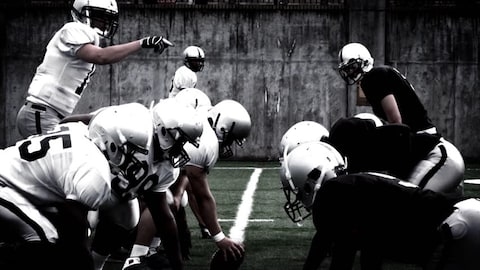
These are a basic understanding of Canadian Football rules as used by CFL.
FIELD
The Canadian football field is 150 yards x 65 yards wide, within which the goal areas are 20 yards deep, and the goal lines are 110 yards apart.
In the case of Molson Stadium, in Montreal,PQ (home of the Montreal Alouettes), there is a surrounding running track, also the case for university stadiums, the end zones are often cut off in the corners to accommodate the track. The end zones in Toronto's BMO Field are only 18 yards instead of 20 yards.
kickoff
At the beginning of a game, the referee tosses a coin and allows the captain of the visiting team to call heads or tails who then has the option of either to kick off or receive or which direction of the field to play in. Teams usually choose to defer so the team that wins the coin toss to kick to begin the first half and receive in the second.
Kickoff starts from the 35 yard line.
Set OF DOWNS
The offence team receives 3 downs in which a team must gain 10 yards within the set of downs or attempts (4 in American Football) and gain another set of downs for every 10 yards gained until the team scores either a touchdown or field goal.
If a team gains say 2 yards on their first attempt, then this would mean they are 2nd and 7.
If a team fails to make 10 yards after their set of downs or a score, the defence becomes the offence at the yard line where it ends. However, after two failed attempts, a team may attempt a field goal on 3rd down or punt by kicking the ball to the opposing team as far down the field as possible to negatively impact the opponent.
SCrimmage
There are 2 teams of 12 players (11 in American football). The team in possession of the ball is the 'offence' and the defending team is the 'defence'.
Play begins with a backwards pass through the legs called a 'snap' and the receiver of the snap is the Quarterback who throws to a member of the offence.
SCORING
Touchdown - 6 points
This is when a player crosses their opponent's end zone, or when the ball crosses or touches the plane of the opponent's goal-line.
Conversion - 1 point/2points
After a touchdown, the scoring team gets one scrimmage play to attempt to add one or two more points. If they make what would normally be a field goal, they score one point (a "point-after"); and what would normally be a touchdown scores two points (a "two-point conversion"). In amateur games, this scrimmage is taken at the opponents' 5-yard line.
Each attempt is taken from the 25-yard line for a conversion and the 3-yard line for the 2-point conversion.
Field goal - 3 points
This is scored either by a drop kick or place kick (except on a kickoff) when the ball, after being kicked and without again touching the ground, goes over the cross bar and between the goal posts (or between lines extended from the top of the goal posts) of the opponent's goal, worth three points. If the ball hits the upright above the cross-bar before going through, it is not considered a dead ball, and the points are scored.
If the field goal is missed, but the ball is not returnable after crossing the dead-ball-line, then it constitutes a rouge (see below).
Single (rouge) - 1 points
This is scored when the ball becomes dead in the possession of a team in its own goal area, or when the ball touches or crosses the dead-line, or side-line-in-goal, and touches the ground, a player, or some object beyond these lines as a result of the ball having been kicked from the field of play into the goal area by the scoring team. It is worth one point. This is different from a Safety (see above) in that team scored against receives possession of the ball after the score.
Safety - 2 points
Scored when the ball becomes dead in the possession of a team in its own goal area, or when the ball touches or crosses the dead-line, or side-line-in-goal and touches the ground, a player, or some object beyond these lines as a result of the team scored against making a play. The ball is then turned over to the receiving team (who gained the two points), by way of a kickoff from the 25-yard line or scrimmaging from the 35-yard line on their side of the field.
Overtime
In the CFL, if the game is tied at the end of regulation play, then each team is given an equal number of offensive possessions to break the tie. A coin toss is held to determine which team will take possession first; the first team scrimmages the ball at the opponent's 35-yard line and conducts a series of downs until it scores or loses possession. If the team scores a touchdown, since the 2010 season, it is required to attempt a two-point conversion. The other team then scrimmages the ball at the opponent's 35-yard line and has the same opportunity to score. After the teams have completed their possessions, if one team is ahead, then it is declared the winner; otherwise, the two teams each get another chance to score, scrimmaging from the other 35-yard line. After this second round, if there is still no winner, during the regular season the game ends as a tie. In a playoff game, the teams continue to attempt to score from alternating 35-yard lines, until one team is leading after both have had an equal number of possessions.
